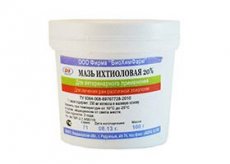Medical expert of the article
New publications
Preparations
Ichthyol ointment
Last reviewed: 03.07.2025

All iLive content is medically reviewed or fact checked to ensure as much factual accuracy as possible.
We have strict sourcing guidelines and only link to reputable media sites, academic research institutions and, whenever possible, medically peer reviewed studies. Note that the numbers in parentheses ([1], [2], etc.) are clickable links to these studies.
If you feel that any of our content is inaccurate, out-of-date, or otherwise questionable, please select it and press Ctrl + Enter.

The drug Ichthyol ointment is used for arthritis and neuralgia, which have a traumatic and inflammatory nature, burns, erysipelas, eczema, prostatitis, metritis, parametritis, salpingitis and other inflammatory processes in the pelvis.
Indications Ichthyol ointment
The drug Ichthyol ointment is used for arthritis and neuralgia, which have a traumatic and inflammatory nature, burns, erysipelas, eczema, prostatitis, metritis, parametritis, salpingitis and other inflammatory processes in the small pelvis. It is also indicated for discoid lupus erythematosus, rosacea, solar eczema and light pox, infiltrative-suppurative types of microsporia and trichophytosis, streptoderma and staphyloderma.
 [ 1 ]
[ 1 ]
Release form
The medicine is produced in the form of an ointment with a dark-brown color, smelling of ichthyol. Ichthyol ointment is packaged in aluminum tubes of twenty grams each, each tube is packed in a cardboard box and supplied with a leaflet with instructions. The composition of the drug contains twenty grams of ichthyol, as well as a certain amount of auxiliary substances - emulsifier type T-2 and medical vaseline.
 [ 2 ]
[ 2 ]
Pharmacodynamics
Ichthyol ointment has strong local anti-inflammatory and antiseptic effects, as well as antipruritic and keratostatic qualities.
The active component ichthyol has a therapeutic effect due to the content of thiophenol components, the main one of which is thiophene. These substances contain up to ten and a half percent of sulfur, which has an organically bound form. These components are capable of acting bactericidally on gram-positive microflora, as well as on yeast-like fungi. The drug does not have the quality to destroy gram-negative microflora.
After applying the preparation, warmth and hyperemia occur at the site of application. Such effects are due to the stimulation of tissue receptors by the ointment components, which are responsible for pain sensations and thermoreceptors. Within one or two hours, the preparation penetrates into the soft tissues under the skin and has an anti-inflammatory and analgesic effect there.
The anti-inflammatory effect is due to a decrease in the production of mediators that are responsible for inflammatory processes, as well as an acceleration of metabolism and inhibition of the delivery of leukocytes to the sites of inflammation.
The active component of Ichthyol ointment is able to relieve itching sensations, as well as excessive keratinization of the skin. Ichthyol also has a photoprotective effect and helps reduce the sensitivity of the skin to ultraviolet radiation.
Pharmacokinetics
If you apply Ichthyol ointment to an intact area of skin and cover it with an occlusive dressing, the ointment begins to be absorbed slowly. The level of systemic absorption is from five to ten percent. The part of the thiophenol components that are absorbed through the skin enters the bile and is removed from the body through the intestines with feces.
Dosing and administration
For muscle pain, arthritis and neuralgia, Ichthyol ointment should be spread evenly over the skin surface above the affected area. After that, the ointment is covered with a gauze napkin and secured with a bandage. Then you need to wash your hands. The bandage is changed once a day. The ointment is applied in an amount of two to four centimeters of the drug squeezed out of the tube.
Use Ichthyol ointment during pregnancy
During pregnancy and lactation, Ichthyol ointment should be used only after assessing the level of risk to the fetus, which turns out to be much lower than the expected benefit to the mother.
Side effects Ichthyol ointment
The appearance of local allergic reactions – itching and burning of the skin, redness and hyperemia.
 [ 10 ]
[ 10 ]
Overdose
- Low systemic absorption of the drug practically cannot lead to an overdose of Ichthyol ointment.
- The possibility of overdose symptoms appears only in case of oral use of the medicine. Symptoms of dizziness, burning in the stomach, nausea and vomiting, diarrhea, as well as bradycardia and decreased blood pressure may be observed.
- Therapy includes gastric lavage and supportive and symptomatic treatment.
- There is no specific antidote to treat drug overdose problems.
 [ 13 ]
[ 13 ]
Interactions with other drugs
Ichthyol ointment enhances the effect of other products that have photoprotective properties, but is incompatible with zinc oxide preparations, which prohibits their combined use.
The ointment should not be used together with solutions and lotions containing iodine salts, alkaloids, and heavy metal salts.
Systemic absorption of the drug is enhanced if it is used simultaneously with dimethyl sulfoxide, ethyl alcohol and glycerin. Also, such symbiosis can lead to an increase in the depth of penetration of the ointment into the soft tissues under the skin.
Attention!
To simplify the perception of information, this instruction for use of the drug "Ichthyol ointment" translated and presented in a special form on the basis of the official instructions for medical use of the drug. Before use read the annotation that came directly to medicines.
Description provided for informational purposes and is not a guide to self-healing. The need for this drug, the purpose of the treatment regimen, methods and dose of the drug is determined solely by the attending physician. Self-medication is dangerous for your health.

